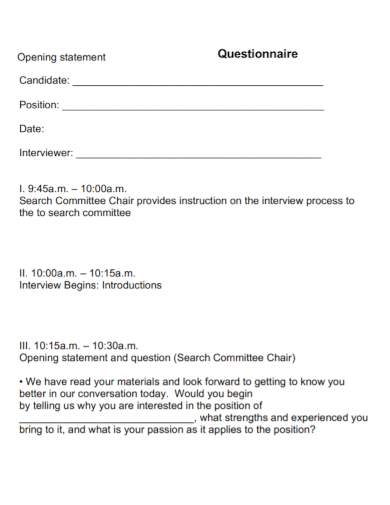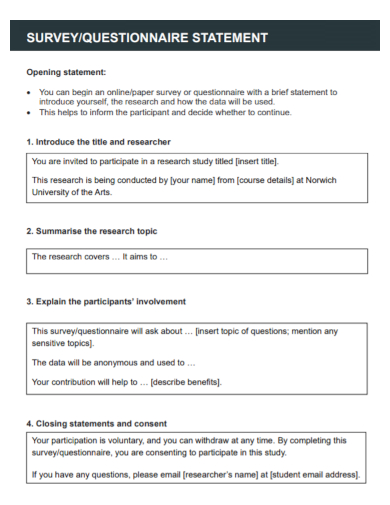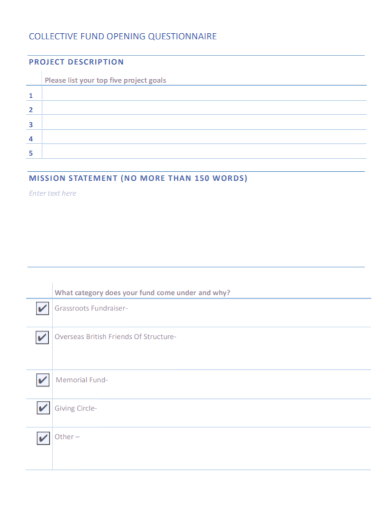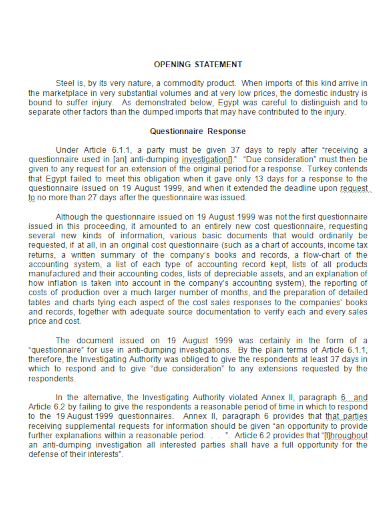Surveys or questionnaires are important parts of conducting any type of research especially if your study involves people’s behaviors, attitudes, views, and behaviors on certain topics. Every researcher is aware that formulating questions for the survey is highly important, but does everyone know that writing the opening statement is just as crucial as well? Having an opening statement can orient the respondents, the people who are asked to fill out the questionnaire, know what they are getting into. It can also help them decide if the survey is worth their time to answer. To help you make a compelling survey introduction, read the article below to find out how to make a questionnaire opening statement.
3+ Questionnaire Opening Statement Samples
1. Questionnaire Opening Statement
2. Survey Questionnaire Opening Statement
3. Opening Questionnaire Mission Statement
4. Questionnaire Response Opening Statement
What is a Questionnaire Opening Statement?
A questionnaire opening statement, or also called questionnaire introduction or survey introduction, describes the questionnaire or survey that the respondents are about to answer. The opening statement can make or break your questionnaire to be answered by your respondents. It determines whether the questionnaire will be answered or ignored. A good questionnaire opening statement should have three qualities that ensure that respondents will answer the questionnaire:
- It must outline the major information about your survey: Your respondents need to know what they are getting into before filling your questionnaire and the introduction can give the information about the survey.
- It’s a good way to welcome respondents: Your introduction is also an opportunity to make your survey personal and letting your respondents know that their answers matter. You are also asking a favor to them by answering your survey. Show your gratitude by making them feel important.
- Survey introductions help you gain respondents’ trust: Filling out surveys is not everyone’s cup of tea that’s why your introduction must push your respondents to answer. Many people are not excited about filling surveys and questionnaires, which is why they need a push and your introduction can persuade them to continue filling your survey.
How to Write a Questionnaire Introduction
Knowing how to write a questionnaire introduction can do wonders for your survey. Ditch the all too formal introduction that bores the respondent within two seconds of reading it. Furthermore, if you don’t really know how to write the introduction poses a lot of questions to the respondents that inhibit them to trust you in obtaining their information. Here are some ways on how to create a questionnaire introduction:
1. Provide All Relevant Information
Writing the introduction doesn’t have to include all information regarding your survey. You only need to include the essential information and the trigger that pushes your respondents to take action. Here are the following points to help you write a proper introduction:
- Purpose of your survey: Let people know the reason for your survey and what you want to achieve with it. Respondents are curious to know what benefits you can get from their answers and knowing that will persuade more people to answer the survey and helps them see the value of your research. Don’t forget to also introduce yourself. Respondents would like to know to whom they are giving their answers.
- Type of audience the respondents are: Respondents are aware that some surveys require only a specific group of people to answer them. Inform them of the reason why they are the target audience and how they are qualified to answer your questionnaire.
- Privacy matters: Surveys usually collect some personal information from the respondents and not all are cool with that. Be transparent with your respondents on what you plan to do and not do with the collected information and the reason for it. Give also an opportunity for your respondents to opt-out if they are comfortable with answering your survey. Being transparent about the privacy matters of your surveys will ease respondents into answering more truthfully.
- Duration of the survey: Respondents want to know how long it will take them to answer the survey. If you fail to mention it in the introduction, the respondents will get exasperated on filling out long surveys and give up halfway through. Try to give them a realistic estimate of the time it’ll take to answer your questionnaire.
- Give incentives: This technique is what wins people over to willingly answer your questionnaire. People like to gain something when they do something, especially for free. That’s why most researchers give treats like food, coupons, and some big companies pay people to answer surveys. Giving incentives will make the respondents answer the questionnaire’s inquiries more honestly.
2. Give Clear Instructions
Be clear about what your readers actually have to do in the survey or questionnaire. Keep the instructions as clear as possible. To help you determine, if your instructions are understandable, ask someone to take the survey first. If they are confused by your questions and your instructions, the people who will be taking your survey will definitely be confused too.
3. Give a Simple Thank You
Don’t forget to show your gratitude and appreciation to your respondents by saying thank you. It humanizes your whole introduction schtick. A heartfelt thank you to the respondents differentiates your questionnaire compared to the rest out there. It makes you seem friendly, nice, and warm.
FAQs
What are the different types of survey introduction?
The different types of survey introduction are market survey introduction, student survey introduction, research questionnaire introduction, and customer satisfaction survey.
What are the four types of questions used in questionnaires?
The four types of questions used in surveys or questionnaires are general or yes/no questions, special questions using wh-words, choice questions, and tag/tail questions.
What are the two types of questionnaire?
The two types of questionnaires are structured and unstructured questionnaires.
Make sure your survey introduction is brief and concise, especially if your questionnaire is filled with long questions. People don’t want to waste any time reading page-long introductions before they can start your answering your survey. By writing up your survey introduction as short as possible, you force yourself to only focus on the most important message. Getting them to answer your questionnaire is the bottom line of it all. To help you get started on writing an introduction for your questionnaire, you can refer to our free sample templates provided above!
Related Posts
FREE 10+ Charity Equality and Diversity Policy Samples
FREE 9+ Sample Employee Exit Forms
FREE 8+ Sample Background Check Release Forms
FREE 8+ Client Confidentiality Agreement Templates
FREE 7+ Sample Needs Assessment
FREE 11+ Mortgage Broker Business Plan Samples
FREE 10+ Agency Profile Samples
FREE 10+ Autobiography Outline Samples
FREE 9+ Sample Photography Consent Forms
FREE 8+ Sample Medical Information Disclaimers
FREE 6+ Sample Self Review
FREE 7+ Charity Register Samples
Dos in Writing Your Self-Evaluation
FREE 40+ Sample Objectives
FREE 13+ Operating Statement Samples




